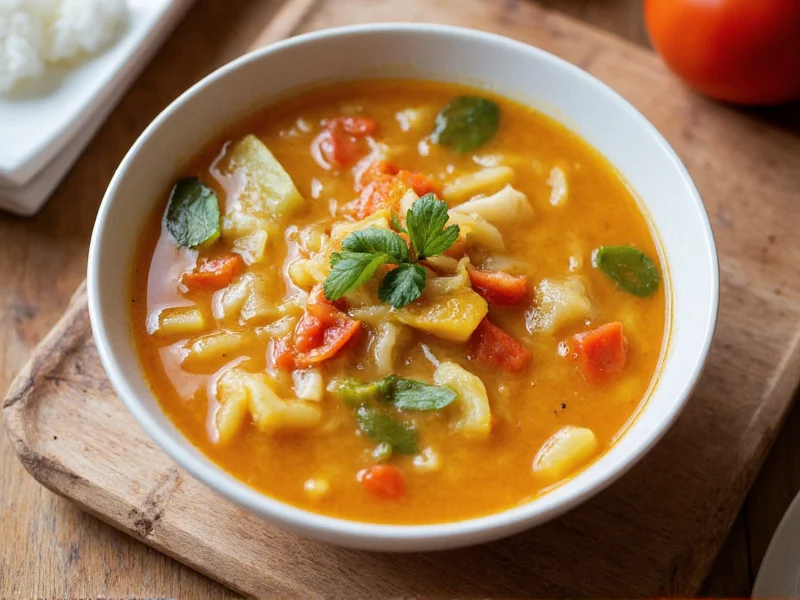For home cooks seeking wholesome comfort food, this traditional recipe transforms humble ingredients into a deeply flavorful meal. Unlike restrictive cabbage soup diets, our balanced approach maintains nutritional integrity while delivering satisfying taste. The natural sulfur compounds in cabbage work synergistically with antioxidant-rich vegetables to create a healing broth that's both economical and versatile.
Why This Recipe Stands Out
Most online recipes either oversimplify this classic dish or add unnecessary ingredients that compromise its therapeutic benefits. Our tested formula preserves the soup's digestive-friendly properties while enhancing flavor complexity through proper vegetable layering and seasoning techniques. The secret lies in the "aromatic base" preparation method that develops rich umami notes without meat products.
Essential Ingredients Breakdown
Quality ingredients make the difference between bland and brilliant cabbage soup. Here's what you'll need and why each component matters:
| Ingredient | Quantity | Functional Purpose |
|---|---|---|
| Green cabbage | 1 medium head | Provides fiber, vitamin C, and sulfur compounds for detoxification |
| Yellow onion | 1 large | Creates flavor foundation and prebiotic benefits |
| Carrots | 2 medium | Adds natural sweetness and beta-carotene |
| Celery stalks | 3 stalks | Contributes mineral content and aromatic depth |
| Garlic cloves | 3 | Boosts immune properties and flavor complexity |
| Vegetable broth | 6 cups | Use low-sodium for better flavor control |
| Tomato paste | 2 tbsp | Enhances umami and balances cabbage bitterness |
| Diced tomatoes | 1 (14.5 oz) can | Adds acidity and texture contrast |
Step-by-Step Preparation Guide
Follow these professional techniques for optimal flavor development:
- Prepare vegetables properly: Slice cabbage into thin ribbons (not chunks) for even cooking. Cut carrots and celery into uniform 1/4-inch pieces.
- Build flavor foundation: Sauté onions in olive oil over medium heat until translucent (5 minutes). Add carrots and celery, cooking until slightly softened.
- Develop umami base: Stir in tomato paste and cook for 2 minutes until it darkens slightly. This crucial step creates rich flavor compounds.
- Add aromatics: Incorporate minced garlic and cook for 30 seconds until fragrant (don't let it brown).
- Layer cabbage correctly: Add half the cabbage, stirring to coat with the vegetable mixture. Cook for 5 minutes until slightly wilted before adding remaining cabbage.
- Simmer properly: Pour in broth and diced tomatoes. Bring to boil, then reduce heat to low. Cover and simmer for 35-40 minutes until vegetables reach desired tenderness.
- Season at the end: Add salt, pepper, and herbs during the last 5 minutes of cooking to preserve their flavor integrity.
Popular Variations for Different Dietary Needs
Customize this base recipe to suit various preferences while maintaining nutritional benefits:
- Protein boost: Add 1 cup white beans or lentils during the last 20 minutes of cooking
- Keto adaptation: Include 1/2 cup chopped cauliflower and reduce carrots by half
- Spicy version: Stir in 1/2 teaspoon red pepper flakes with the garlic
- Creamy texture: Blend 2 cups of finished soup and return to pot
- Root vegetable twist: Add 1 diced parsnip and 1 small sweet potato
Serving and Storage Recommendations
Maximize both flavor and nutritional value with these professional tips:
- Flavor development: This soup tastes better the next day as flavors meld. Prepare ahead for optimal taste.
- Serving temperature: Serve hot but not boiling to preserve vitamin content.
- Freezing instructions: Cool completely before freezing in portion-sized containers for up to 3 months.
- Reheating method: Warm gently over medium-low heat to prevent vegetable breakdown.
- Perfect pairings: Serve with whole grain bread or a simple green salad for complete nutrition.
Frequently Asked Questions
How long does homemade vegetarian cabbage soup stay fresh?
Properly stored in airtight containers, this soup maintains freshness for 4-5 days in the refrigerator. The flavor actually improves after 24 hours as ingredients meld. For longer storage, freeze portions for up to 3 months without significant quality loss.
Can I make this soup without tomatoes for acid reflux?
Absolutely. Omit tomatoes and increase carrots by 50% for natural sweetness. Add 1 teaspoon lemon juice at the end of cooking for brightness without acidity. Many find cabbage soup actually helps soothe digestive issues when prepared without acidic components.
What's the best way to reduce cabbage's strong odor while cooking?
Adding a bay leaf or slice of lemon to the broth significantly reduces cooking odors. Proper ventilation helps, but the most effective method is cooking the cabbage in two stages - first sautéing half the cabbage with aromatics, then adding the remainder later in the process as described in our recipe.
How can I make vegetarian cabbage soup more filling for weight management?
Add 1/2 cup cooked lentils or white beans per serving to increase protein and fiber content without significantly raising calories. Chopping vegetables smaller creates more surface area, triggering greater satiety signals. The soup's natural water content and fiber work together to promote fullness while providing minimal calories.
Which cabbage variety works best for soup?
Green cabbage offers the classic flavor and firm texture ideal for soup. Savoy cabbage provides a more delicate flavor and tender texture but breaks down faster. For maximum nutritional benefit, use a combination of green and red cabbage - the anthocyanins in red cabbage boost antioxidant content significantly.











 浙公网安备
33010002000092号
浙公网安备
33010002000092号 浙B2-20120091-4
浙B2-20120091-4